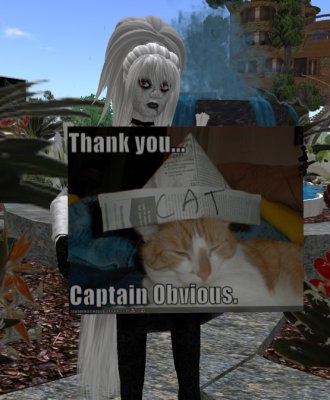
Upon reading the comments and articles generated by “Students vs Second Life“, I had several prominent thoughts:
- There’s nothing so rarely discussed as “the obvious”. Often things that are considered to be obvious are then not subjected to further thought or discussion, the problem often being that the thing is rarely obvious to everyone. I’m sure the original article was obvious for some, but not for others. Regardless, solutions need to be found for those using Second Life as an educational tool;
- A generation is a statistical grouping: it cannot predict the behavior or capabilities of the individual. A generation can only describe trends amongst people or things; also, it can only be used to describe how something acts as a group. This may mean that all the folks on the Teen grid are not wholly representative of their generation – considering how few of them there are, this does not seem an unreasonable assumption;
- Second Life is a fantastic product for an underdeveloped market segment: Generation X. For Second Life (and future products of its ilk) to have the greatest life-span possible, will require acceptance that younger people need to be drawn in. Otherwise, it’s more likely that the Millennials will stay within their comfort zone of other virtual worlds;
- Millennials who remain inside Second Life may be the anomalies, when compared to the generational stereotype. They are either unusually self-directed, or have found a way of turning the Second Life tool to their own devices – perhaps as an alternative way to interact with people;
- Second Life, as opposed to other virtual worlds, has a greater scope for forms of interaction, because you can create in a more sophisticated way. Second Life is clunky and difficult – but it’s hard to create a sleek, wonderful interface and backbone that still does everything Second Life can do now, given the resources available;
- Individuals of the Millennial generation are not the only ones necessarily lacking in the skill of freeform play – other generations contain individuals lacking the skill also. However, it is just that – a skill, which can be learned. So why should we bother to learn it? It broadens our creative horizons, and teaches us to think, particularly about things which seem obvious;
- The human race is still essentially tribal, which also means that we are exclusionary. Our differences can exclude us from any given tribe. Fancy being the only person of your age on your street spending time in Second Life rather than Habbo Hotel?
Here is a brief wrap-up of what other folks had to say, having read the article:
Kate Amdahl suggests that we create “learning” areas – areas which have pre-generated content, games and interactive mechanisms, to get folks used to the interface and get them spending time in Second Life. From these places, they can make forays out into the rest of the world, and gradually incorporate the overall idea of Second Life into their play-style.
Sabine Reljic seems to indicate that we would be well rewarded by pushing students into Second Life and out of their comfort zones. I wonder what that would look like. Right now, it would seem that pushing students into Second Life and leaving them to their own devices results in them wandering around lost or standing around chatting. This view is supported by the VirtuEd post. Additionally, pushing teens and young adults tends to result in them pushing back – caution is indicated.
Roland Legrand over at Metanomics has written a great post about what the Millennials know about multi-tasking and collaboration that they can teach the rest of us: “we also have an obligation to help them” learn about freeform play.
Over at New World Notes, this post gathered all sorts of interesting comments, and this second post ponders the question of why Habbo Hotel is so popular amongst young Millennials, as opposed to Second Life or Teen Second Life. Of the comments, the most interesting was one which wonders whether Generation X has more of a need to escape into fantasy than the Millennial generation. Did Gen X’ers grow up in a more hostile environment, from which they looked for relief?
At Massively, Tateru Nino states: “Where it might be that they would find additional traction if they could cluster with their cultural peers — members of their own generation — digital avatars consistently thwart the sorts of flocking behaviors. Millennials can’t identify their peers among the avatars of their parents and grandparents’ generations — and for the peer-oriented Millennials, that’s frequently a deal-breaker.” Also, “The very nature of Second Life turns away Millennials in droves. As entertainment, it is as undirected as a public park.”
A study by the University of Leipzig supports the finding that there are few Millennials in Second Life. They state that this is because Second Life is too realistic, and that virtual worlds should be centered around escapism.
All in all, there seems to be a fascinating spectrum and crossover of viewpoints on the topic, many supported by direct, accreted experience and statistical data. Are your own experiences with students in line with one of these, or do you have a unique perspective to share?
[…] Second Life: many ‘corporate’ islands are becoming ghost towns; and discussion about tribal behavior and generational differences among SL users. As user behavior normalises in SL, I expect we will see several new online worlds attempting to […]